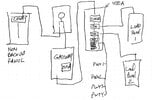Hi everyone - I'm in the final stages of negotiations with my solar installer and before I commit to hard dollars, I'd appreciate some feedback on the proposed system I'd be installing.
Here's some level-set on the house configuration and consumption:
When "idle" (with none of the above running) the house pulls roughly 950W per panel to run TV's, computers, lights, refrigerator, freezers, etc.
When I do my own math, it seems to be sized well, but I'm neither an engineer or solar installer by trade, so I need some input here on how to really look at this properly.
Thank you in advance - I know it's a bit to read through, but I do appreciate any/all feedback.
Here's some level-set on the house configuration and consumption:
- 400A service split across two 200A panels with a single meter
- panels are Leviton Load Centers with smart breakers with LDATA data collection hubs
- House is 100% electric (stove, water heater, etc.) with Geothermal for HVAC (also electric). All of these circuits are on one of the 200A panels.
- Currently have 2 Teslas, both with dedicated wall connectors. They are both energized by two 50A circuits on the second 200A panel.
- The balance of the lights/utilities/etc. are spread relatively evenly across the two 200A panels
- 12-month total home consumption: 33,905 kWh
- 12-month Average monthly consumption: 2,825 kWh
- 12-month Average utility rate: 0.117 / kWh - the actual monthly rate fluctuates due to a "Fuel cost adjustment" and an "environmental surcharge" added to the 0.0896 / kWh base rate
- 31.1 kW in size
- Qty. 84 370W Silfab panels
- estimated to product 36.1kW per year
- projected ~104% energy offset over the course of the year
- Qty. 4 Tesla Powerwall + (2 per panel)
- Qty. 2 Gateways
What other information should I be looking at to know whether this system is truly sized properly for 100% offset for my daily needs?
My Geothermal pulls anywhere from 3-4kW when it's running (which is not continuously), the water heater does the same when it's running, the stove pulls about 2.5kW, etc. Each of the Tesla's pull ~10kW when charging, but I rarely charge them both at the same time... it happens occasionally, but it's the exception rather than the rule. I also wouldn't expect to charge the Teslas from the Powerwalls when the house is running on battery.When "idle" (with none of the above running) the house pulls roughly 950W per panel to run TV's, computers, lights, refrigerator, freezers, etc.
When I do my own math, it seems to be sized well, but I'm neither an engineer or solar installer by trade, so I need some input here on how to really look at this properly.
What's my best Powerwall installation location?
Would it be best to install the Powerwalls in my insulated (but not climate controlled) outbuilding and then run their output across the trenched line to the gateways at the house or would it be best to install the Powerwalls inside my house (on the basement foundation wall; within 20 ft. of my electric service)? I figure the answer there will be related to the the efficiency of pushing the DC from the panel array to the Powerwall's over a distance, but am considering both options and would like some guidance. All of my research says the better spot would be in the basement in the house. The storage room where they would be installed there isn't climate controlled, but it never gets as cold (or as hot) there as it would in the outbuilding.Using the Powerwall + integrated inverters, what's the best way to monitor proper panel operation and to know when I have a panel that's not performing or having an issue?
Having Powerwalls are a necessity for me making this type of investment, and the installer wants to install Powerwall + with integrated inverters. My research shows these to be string inverters and not micro, so I'm curious as to how best to troubleshoot/diagnose the solar array as time goes by.Whole panel vs individual breaker protection with the Powerwalls?
The installer is telling me that the system can be wired to back up the entire panel and I then manage the house load myself when on battery. Other prior quotes from other installers have told me that I'd have to select individual breakers in each panel for the Powerwalls to back up and I'd have limited flexibility on what can stay on when running on battery. What's the general consensus here?Thank you in advance - I know it's a bit to read through, but I do appreciate any/all feedback.



